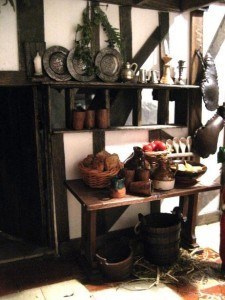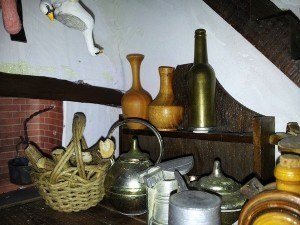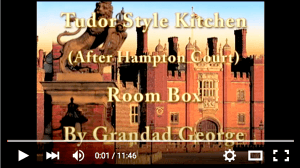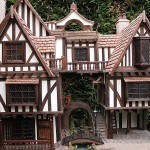Tudor Kitchens
A big difference between Tudor Manor House and Commoner kitchens were just how many they had, and the number of tools and appliances utilized. Hampton Court Palace wins the prize with 147 separate, well-equipped food preparation areas. A Commoner might make do with one large room, with too many cooks falling over each other to bring each coarse to table on time. A dollhouse enthusiast has so much choice when it comes to Tudor kitchen(s). I hope this article can be helpful, and perhaps be an inspiration for an exciting project.
Hampton Court
Believe it or not, the largest manor house in England began as a “starter” home for Thomas Woolsey. When Henry VIII ascended the throne in April of 1509, the future Cardinal was described as follows: “There is in the royal household a priest named Thomas Wolsey, one of a number of royal chaplains, not unlearned in Scripture, a clever fellow, and most ready for any undertaking…’
In other words, Wolsey was a brilliant sycophant, becoming the most powerful advisor to the king. He bought what was described as a “rather small manor house” in 1514 and began an ostentatious building program.
Woolsey’s salad days lasted for only 8 years. The Cardinal fell from grace when he failed to navigate the troubled waters of Henry’s break with Rome. He gave Hampton Court to the King in an attempted to forestal total disgrace. Another failure. Henry confiscated the rest of Woolsey’s lands anyway, and slapped Wolsey in prison for treason. Then Henry began an even more ostentatious building program. When completed, Hampton Court became his favorite palace.
Hampton Court and other buildings of it’s type might be an overwhelming project for miniature enthusiasts, but individual rooms could be great for inspiration. Imagine recreating in miniature a group of kitchens that could feed six hundred or so members of the court, twice a day. Or perhaps the separate kitchens that produced meals “fit for a King” by Henry’s personal chef, known as Peter The Sweet.
The Commoner’s Kitchen
First, consider the word Commoner. It doesn’t mean poor, just that the subject was not of the gentry. As peace settled on the Kingdom during the Tudor reign, and trade increased, a wealthy merchant class developed. Many wanted what their “betters” had and could afford to pay for it. The items in the kitchen of a “timber frame, wattle and daub” dollhouse could be just as pricey and numerous as the utensils in the kitchen’s of the aristocracy.
The main feature in any Tudor kitchen would be the hearth for roasting food. There could be a bread oven on one side of the fireplace, a large cauldron hanging over the fire by a hook. A large table for preparing the food would be centered in the room. There could be stools or benches nearby. (Chairs were very expensive, so only the very rich would have them). There would be wall shelving for food storage. Clay jars and pots were used for storing and cooking food; drying herbs would hang from the fireplace or the shelves. In smaller Tudor homes, the kitchen was also used for bathing and washing, so a big wooden tub might be kept there.
During the Tudor period people began using “trenches,” flat boards with hollows carved out for food. Tin plates also came int usage. Prior to this, large slices of bread served the purpose. Spoons and knives were used for eating, but not forks.
The kitchens were often connected to rooms called the Buttery and the Pantry. Don’t be misled by the word Buttery. That’s where beverages, especially ale, were stored and dispensed from large vats called ‘butts.” The Pantry was intended for the storage of perishable food stuffs. Storerooms were used to store non-perishable kitchen items and products. They often located over the buttery and pantry.
Other Utensils You Might Use
Assorted spoons, skimmers and ladles
Trivets
Racks for roasting spits
Tongs and nippers for gripping hot things
Various bowls and plates: tin or pewter if you afford them, otherwise, otherwise make do with wood
Hanging salt box
Various caldrons and kettles, flat bottom & 3 legged. And skillets
A bundle of rushlights – the poor man’s candle
Mortar & pestle
An hour glass
Hanging lantern
Knives, hatchets
Fireplace tongs and ash shovels
Clay pots, flat bottom & 3-legged
Various sized baskets
The site “Old & Interesting” is a good resources to check what years an item was in use.
And I love this video – Tudor Style Kitchen (After Hampton Court) by Grandad George. It’s a great “how to.”
Have fun!
Susan Downing, with Patrick Owens









